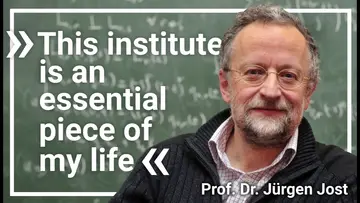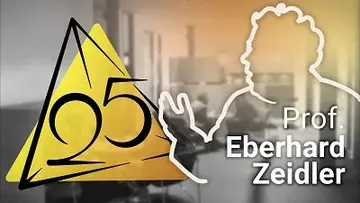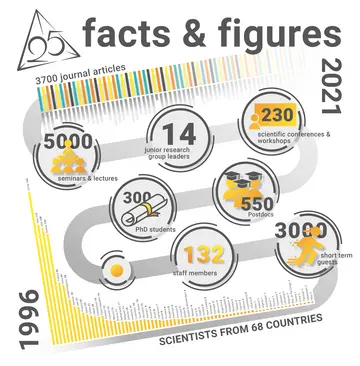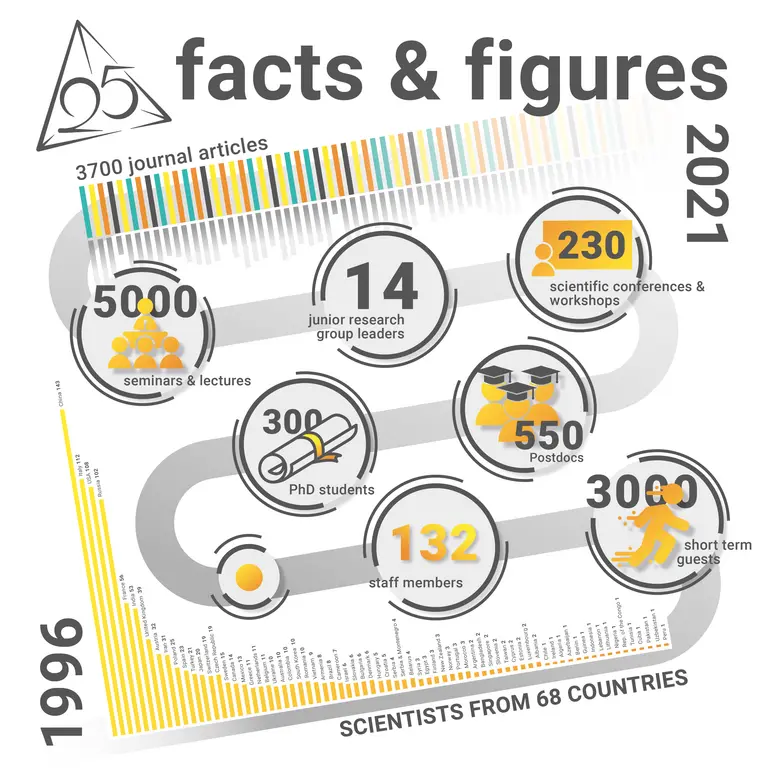
Episode 5 — Facts & Figures
Published May 19, 2021
What would a mathematical institute be without facts and figures? For today's review, we have rummaged through our databases and elicited some statistics from them.
In the past 25 years, at our institute we had/have:
- 132 staff members working in our administration, library, IT and scientific service, including our trainees
- more than 300 PhD students
- more than 550 Postdocs
- 14 Junior research group leaders
- 230 scientific conferences and workshops
- more than 5.000 seminars and lectures
- more than 3.000 short term guests visited our institute within research collaborations, conferences, seminars and other projects
- Our institute published more than 3.700 journal articles
- Our scientists came from 68 different countries. Curious which countries these are? To illustrate this broad spectrum of countries worldwide we prepared a chart for you.
Our directors and their research groups
Jürgen Jost (since 1996)
Riemannian, Kählerian and algebraic geometry, geometric analysis, nonlinear partial differential equations in mathematical physics, calculus of variations, mathematical and theoretical biology, neural networks, theory of cognition, mathematical methods for complex systems, information theory, dynamical and complex systems in economics and social sciences, theory and history of science.
Felix Otto (since 2010)
Analysis of continuum models in materials science (ferromagnets, shape memory alloys) and fluids by methods from partial differential equations and the calculus of variations. Treatment of random effects (stochastic homogenization, thermal noise), pattern formation, energy landscapes, scaling laws.
Bernd Sturmfels (since 2017)
Algebra, geometry and combinatorics with strong connection to applications, drawn from statistics, computer science and the life sciences. Areas like algebraic geometry, commutative algebra, convex and discrete geometry, multi-linear and tensor algebra, algebraic combinatorics, dynamical systems, and symbolic computation are covered.
Wolfgang Hackbusch (1999–2014, retired director)
Numerical solution of partial differential equations and integral equations, Multi-grid methods, Boundary element methods
Stefan Müller (1996–2008, former director)
Mathematical foundations of materials science, microstructures, micromagnetism, continuum mechanics, singular perturbations, non-linear partial differential equations and the calculus of variations
Ensuing position at: Hausdorff Center for Mathematics Bonn (Germany)
Eberhard Zeidler † (1996–2007)
Non-linear partial differential equations, non-linear functional analysis, classical and modern mathematical physics, selected questions of mathematical chemistry and mathematical biology
In addition, 8 research groups are currently working at our institute, led by outstanding young scientists. These are:
- Daniele Agostini: Algebraic geometry and interactions with probability, statistics and mathematical physics, Riemann's theta function
- Benjamin Gess: Stochastic partial differential equations, regularization and well-posedness by noise, random dynamical systems
- Michael Joswig: Polyhedral combinatorics, algorithmic geometry, mathematical software
- Guido Montúfar: Deep learning theory, geometric analysis of capacity, optimization, and generalization in deep neural networks
- Matteo Smerlak: Theoretical evolutionary dynamics, fitness landscapes
- André Uschmajew: Low-rank tensor approximation, numerical tensor calculus, optimization
- Paul Breiding: Emmy Noether Research Group on Numerical and Probabilistic Nonlinear Algebra
- Noémie Combe: Minerva group on Frobenius structures, Operads, Deformation Theory & Applications
We are incredibly proud that all our former group leaders now hold prestigious positions at renowned universities and scientific institutions worldwide.

25 Years MPI for Mathematics in the Sciences 25 Years MPI for Mathematics in the Sciences
All other episodes of our column can be found here.
Editorial Contact
Related Content

Episode 6 — Annual highlights Episode 6 — Annual highlights

Episode 4 — A cool paperclip Episode 4 — A cool paperclip

Episode 3 — Interview with Prof. Dr. Jürgen Jost Episode 3 — Interview with Prof. Dr. Jürgen Jost


